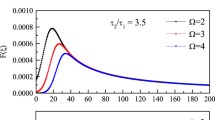Abstract
In this paper, we look at the issue of the high-end of research performance which is captured in the tail of a citation distribution. As the mean is insufficient to capture the skewness of such distributions, a consistency or concentration measure is the additional parameter needed. We show that the h-index is only approximately a heuristic mock of a composite indicator built from three primary indicators which are the number, mean and consistency term. The z-index is able to sense the change in consistency in the distribution due to the outliers in the tail of the distribution.


Similar content being viewed by others
References
De Visscher, A. (2011). What does the g-index really measure? Journal of the American Society for Information Science and Technology, 62(11), 2290–2293.
Garfield, E. (1955). Citation indexes to science: A new dimension in documentation through association of ideas. Science, 122(3159), 108–111.
Garfield, E. (1999). Journal impact factor: A brief review. Canadian Medical Association Journal, 161(8), 979–980.
Garfield, E. (2005). The agony and the ecstasy: The history and meaning of the journal impact factor. In International Congress on Peer Review and Biomedical Publication. Retrieved Oct 15, 2013 from http://garfield.library.upenn.edu/papers/jifchicago2005.pdf.
Glänzel, W. (2009). The multi-dimensionality of journal impact. Scientometrics, 78(2), 355–374.
Glänzel, W. (2013a). High-end performance or outlier? Evaluating the tail of scientometric distribution. Scientometrics, 97(1), 13–23.
Glänzel, W. (2013b). The application of citation-based performance classes in disciplinary and multidisciplinary assessment. In J. Gorraiz, E. Schiebel, Ch. Gumpenberger, M. Hörlesberger, & H. F. Moed (Eds.), Proceedings of ISSI 2013—The 14th International Conference on Scientometrics and Informetrics, Vienna, Austria (Vol. I, pp. 109–122).
Glanzel, W., & Moed, H. F. (2013). Opinion paper: thoughts and facts on bibliometric indicators. Scientometrics, 96(1), 381–394.
Glänzel, W., Thijs, B., Debackere, K. (2013). The application of citation-based performance classes in institutional research assessment. In S. Hinze, A. Lottmann (Eds.), Translational Twists and Turns: Science as a Socio-Economic Endeavour, Proceedings of STI 2013 Berlin (18th International Conference on Science and Technology Indicators) (pp. 122–129).
Hirsch, J.E. (2005). An index to quantify an individual’s scientific research output. In Proceedings of the National Academy of Sciences of the United States of America (Vol. 102, no. 46, pp. 16569–16572).
Pendlebury, D. A., & Adams, J. (2012). Comments on a critique of the Thomson Reuters journal impact factor. Scientometrics, 92(2), 395–401.
Prathap, G. (2010a). Is there a place for a mock h-index? Scientometrics, 84, 153–165.
Prathap, G. (2010b). The 100 most prolific economists using the p-index. Scientometrics, 84, 167–172.
Prathap, G. (2011a). The energy–exergy–entropy (or EEE) sequences in bibliometric assessment. Scientometrics, 87, 515–524.
Prathap, G. (2011b). Quasity, when quantity has a quality all of its own—Toward a theory of performance. Scientometrics, 88, 555–562.
Prathap, G. (2013a). The Zynergy-index and the formula for the h-index. Journal of the American Society for Information Science and Technology. doi:10.1002/asi.23046.
Prathap, G. (2013b). Quantity, quality, and consistency as bibliometric indicators. Journal of the American Society for Information Science and Technology. doi:10.1002/asi.23008.
Prathap, G. (2013c). Measures for impact, consistency, and the h- and g-indices. Journal of the American Society for Information Science and Technology. doi:10.1002/asi.23028.
Author information
Authors and Affiliations
Corresponding author
Rights and permissions
About this article
Cite this article
Prathap, G. Single parameter indices and bibliometric outliers. Scientometrics 101, 1781–1787 (2014). https://doi.org/10.1007/s11192-013-1225-z
Received:
Published:
Issue Date:
DOI: https://doi.org/10.1007/s11192-013-1225-z




